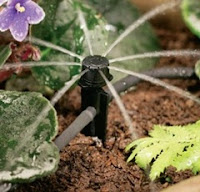Dripper irrigation systems are becoming more popular in the failing economy because they conserve water and help save money. Some cities require dripping irrigation systems due to water shortages. They are also ideal for watering in arid climates because water does not have a chance to evaporate in the heat. There are many reasons why drip watering is so effective:
- Saves money - micro irrigation uses up to 70% less water than conventional sprinkler systems, lowering your monthly water bill
- Conserves water - water is distributed directly to plant roots and does not evaporate
- Saves time - hand watering of plants and garden areas is not needed
- Reduces yard maintenance - water goes directly to plants and not weeds
 Before you begin installation, identify areas that have similar watering needs (i.e trees and shrubs, ground cover and flower beds or gardens, potted and hanging plants). After identifying those areas, you should decide on a water source for your micro irrigation system. You may choose a standard hose faucet, an existing underground lawn irrigation system or it can be directly connected to a sprinkler system valve.
Before you begin installation, identify areas that have similar watering needs (i.e trees and shrubs, ground cover and flower beds or gardens, potted and hanging plants). After identifying those areas, you should decide on a water source for your micro irrigation system. You may choose a standard hose faucet, an existing underground lawn irrigation system or it can be directly connected to a sprinkler system valve.You will also want to check the water pressure of your water source as well. Drip watering systems operate best at a water pressure between 15 and 35 PSI. Any higher water pressure could damage your garden watering system or cause it to fail.
After choosing the water source you want to use, you can begin installing your custom water drip system to water shrubs, trees, flower beds and hanging and potted plants.

No comments:
Post a Comment